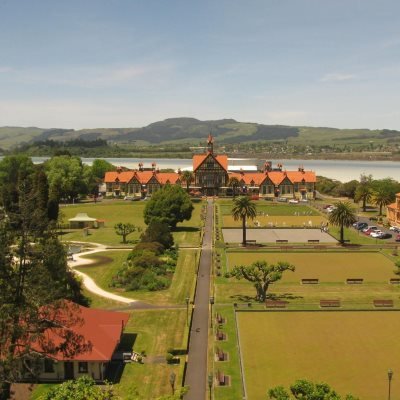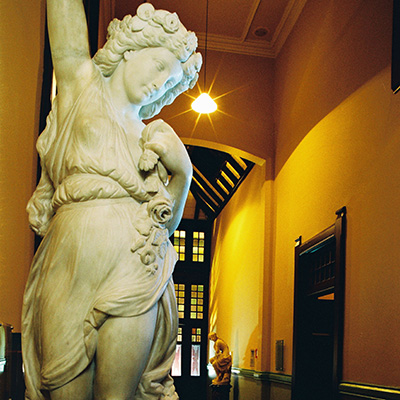Summers’ Sculptures safely tucked away
Saturday, 12 August 2017
As the Bath House building celebrates its 109th birthday some of its most precious inhabitants have just moved out. The iconic marble sculptures that have been housed at the Bath House building for more than 100 years have been safely moved into storage.
The planning around how to safely move these ten heavy yet fragile sculptures started long before completion of the comprehensive assessment which found Rotorua Museum (housed within the historic Bath House building) fell below earthquake safety standards.
Rotorua Museum Exhibition Lead Susan Skellern says the historically significant sculptures are amongst the last artworks to be moved out of the damaged part of the Museum.
“Because of the weight of the sculptures (the heaviest at nearly two tonnes) and the issues around floor loading in the Museum foyer, we had to enlist the expertise of building and engineering specialists to work with conservators and our Museum team to carry out this project.”
Engineers, GDC, designed a timber floor pathway to spread the weight of the sculptures and moving machines. The path needed to enable the large sculptures to be turned in confined spaces and allow for their removal through the Museum foyer and front doors. The extraction path also had to follow the foundation structure located below in the basement.
Specialist sculpture and artwork moving company Rich Riggers from Auckland, were contracted to assess the weight and dimensions of each sculpture and to determine the most appropriate machinery to move each one, based on maximum loading in that area.
Expert conservators Detlef Klein and Marco Bürger helped develop the detailed work plan for the extraction process and the design of individual storage crates unique to each sculpture. The crates are made of untreated timber and include special archival foam packing to restrict any movement. Once the sculptures
were packed, each crate had to be wrapped in a plastic that allows for air ventilation.
Local builders spent weeks making the specially designed crates and laying the flooring pad in preparation for moving day.
On Thursday 10 and Friday 11 August the teams and Rotorua Museum’s own collection experts came together to put months of research and planning into action. All ten marble sculptures were safely moved to the Rotorua Museum off-site storage facility.
Rotorua Museum Collections Lead Cat Jehly said it was very important to preserve these iconic sculptures.
“As well as being a well-known feature in the Bath House building for more than 100 years, this is the world’s largest collection of sculptures by father and son artists Charles Francis Summers Senior and Junior.”
Made from Italian Carrara marble, these works were bought when the Bath House opened in 1908 to add to the feeling of grandeur and opulence in the Elizabethan building.
The neo-classical sculptures have adorned the hallways of the Bath House building since its days as a medical facility, through the Tudor Towers era as a restaurant and nightclub, and as an important part of the art gallery and museum.
Rotorua Lakes Council Arts and Culture Director Stewart Brown said the removal was carried out without any hitches thanks to the detailed planning and care taken by all involved.
“Most of the taonga in compromised areas of the Museum were moved a long time ago but due to the complexity of the process, the Summers’ Sculptures have had to remain in place until now. It is great to now have them safely stored.”
ENDS
For further information:
Kathy Nicholls, Events Coordinator, Rotorua Museum, Ph: 07 351 8456 or 0276 741 898
Image credits: Moving Summers’ Sculptures, August 2017. Photographs courtesy of Rotorua Museum Te Whare Taonga o Te Arawa.
Larger resolution images available upon request.











